| Srl | Item |
| 1 |
ID:
143607
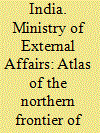

|
|
|
|
|
| Publication |
New Delhi, Ministry of External Affairs, 1960.
|
| Description |
Mapspbk
|
|
|
|
|
|
|
|
|
|
|
|
Copies: C:1/I:0,R:0,Q:0
Circulation
| Accession# | Call# | Current Location | Status | Policy | Location |
| 029767 | 912.54/IND 029767 | Main | On Shelf | General | |
|
|
|
|
| 2 |
ID:
129014
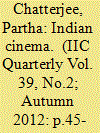

|
|
|
| 3 |
ID:
112136


|
|
|
|
|
| Publication |
2012.
|
| Summary/Abstract |
The historical trading communities of early twentieth century Ladakh, in northern India, interacted with multiple cultures through both travel and the flow of trade goods. Using a neo-pragmatic philosophical framework, I will argue that this community-largely rural and commonly thought of as isolated-was, in fact, cosmopolitan. The traders' interactions with specific commodities prompted them to traverse cultural boundaries and engage with new ideas. This view of cosmopolitanism suggests that, while particular economic, political or social contexts may be part of the settings in which both individuals and communities are engaged in cosmopolitan processes, contexts do not define the cosmopolitan.
|
|
|
|
|
|
|
|
|
|
|
|
|
|
|
|
| 4 |
ID:
140806
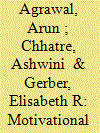

|
|
|
|
|
| Summary/Abstract |
We used a quasi-experimental research design to study the extent of motivational crowding in a recent sustainable development intervention in northern India. The project provided participants with both private and communal material benefits to enhance their incomes, and environmental and social information to inculcate pro-environmental motivations. We compared changes in reported motivations of participants for conserving forest resources, before and after project implementation, with changes in reported motivations of matched nonparticipants. We found that villagers who received private economic benefits were more likely to change from an environmental to an economic motivation for forest protection, whereas those who engaged in communal activities related to the project were less likely to change from an environmental to an economic motivation. These results, which indicate a substantial but conditional degree of motivational crowding, clarify the relationships between institutional change, incentives, and motivations and have important implications for the design of sustainable development interventions.
|
|
|
|
|
|
|
|
|
|
|
|
|
|
|
|
| 5 |
ID:
128505
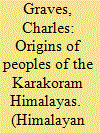

|
|
|
|
|
| Publication |
2013.
|
| Summary/Abstract |
The scholarly search for the origin of the people of this region often falls victim to the complex religious history of the area. If we leave aside the question of the religions of the people it may be possible to determine which 'peoples' at an early age inhabited the region up until recently called 'The Princely State of Jammu and Kashmir'. At 3,500 years ago (at 1,500 BPE - 'before the Present Era') the Indo- Aryans had already entered the Ganges plain and presumably there were some other elements of migrations from Central Asia which reached the more northerly areas of India called Kashmir. Moreover, it is possible some 'aboriginal' groups from Rajasthan and Gujarat had penetrated Kashmir as well as other parts of the sub-continent. Also some 'Dravidian' speakers (arriving in the sub-continent circa. 2,500 BPE) could have come to Kashmir.
|
|
|
|
|
|
|
|
|
|
|
|
|
|
|
|
| 6 |
ID:
139675
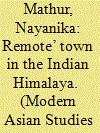

|
|
|
|
|
| Summary/Abstract |
This article studies the impact of the creation of a new state in northern India through an analysis of space. The space under consideration is the town of Gopeshwar, which serves as the administrative headquarters of a district in the state of Uttarakhand. Uttarakhand was created as a distinct Himalayan state in 2000 after a prolonged period of mass agitation to this end. The movement for statehood had emphasized historical neglect coupled with exploitation of
the mountains of Uttarakhand by the plains. Beginning with an analysis of the town plan, this article moves on to describe how this place is made into a space by everyday practices. In particular it concentrates on the narratives of agents of the state who express a longing to escape this ‘remote’ town. Through an interrogation of the trope of remoteness, this article argues that the creation of the new state has served, ironically enough, to accentuate the traditional characterization of the Himalaya as a backward, inferior space within India.
|
|
|
|
|
|
|
|
|
|
|
|
|
|
|
|